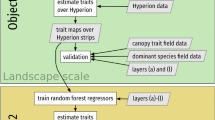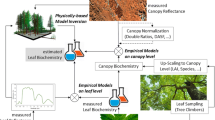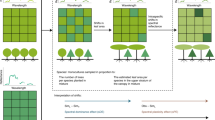Abstract
Mapping biological diversity is a high priority for conservation research, management and policy development, but few studies have provided diversity data at high spatial resolution from remote sensing. We used airborne imaging spectroscopy to map woody vascular plant species richness in lowland tropical forest ecosystems in Hawai’i. Hyperspectral signatures spanning the 400–2,500 nm wavelength range acquired by the NASA Airborne Visible and Infrared Imaging Spectrometer (AVIRIS) were analyzed at 17 forest sites with species richness values ranging from 1 to 17 species per 0.1–0.3 ha. Spatial variation (range) in the shape of the AVIRIS spectra (derivative reflectance) in wavelength regions associated with upper-canopy pigments, water, and nitrogen content were well correlated with species richness across field sites. An analysis of leaf chlorophyll, water, and nitrogen content within and across species suggested that increasing spectral diversity was linked to increasing species richness by way of increasing biochemical diversity. A linear regression analysis showed that species richness was predicted by a combination of four biochemically-distinct wavelength observations centered at 530, 720, 1,201, and 1,523 nm (r 2 = 0.85, p < 0.01). This relationship was used to map species richness at approximately 0.1 ha resolution in lowland forest reserves throughout the study region. Future remote sensing studies of biodiversity will benefit from explicitly connecting chemical and physical properties of the organisms to remotely sensed data.








Similar content being viewed by others
References
Asner GP, Elmore AJ, Hughes RF, Warner AS, Vitousek PM. 2005. Ecosystem structure along bioclimatic gradients in Hawaii from imaging spectroscopy. Remote Sens Environ 96:497–508
Asner GP, Vitousek PM. 2005. Remote analysis of biological invasion and biogeochemical change. Proc Natl Acad Sci USA 102:4383–6
Clark M, Roberts DA, Clark DB. 2005. Hyperspectral discrimination of tropical rain forest tree species at leaf to crown scales. Remote Sens Environ 96:375–98
Cochrane MA. 2000. Using vegetation reflectance variability for species level classification of hyperspectral data. Int J Remote Sens 21: 2075–87
Cohen WB, Spies T. 1990. Semivariograms of digital imagery for analysis of conifer canopy structure. Remote Sens Environ 34: 167–178
Curran PJ. 1989. Remote sensing of foliar chemistry. Remote Sens Environ 30:271–8
Gaston KJ. 2000. Global patterns in biodiversity. Nature 405:220–227
Giambelluca TW, Nullet MA, Schroeder TA. 1986. Rainfall atlas of Hawaii. Honolulu (HI): Department of Land and Natural Resources, State of Hawaii. p 267
Givnish TJ. 1999. On the causes of gradients in tropical tree diversity. J Ecol 87: 193–210
Gotelli NJ, Colwell RK. 2001. Quantifying biodiversity: procedures and pitfalls in the measurement and comparison of species richness. Ecol Lett 4: 379–391
Gould W. 2000. Remote sensing of vegetation, plant species richness, and regional biodiversity hotspots. Ecol Appl 10:1861–70
Green RO, Eastwood ML, Sarture CM, Chrien TG, Aronsson M, Chippendale BJ, Faust JA, Pavri BE, Chovit CJ, Solis M, Olah MR, Williams O. 1998. Imaging spectroscopy and the airborne visible/infrared imaging spectrometer (AVIRIS). Remote Sens Environ 65:227–248
Heywood VH, Watson RT, Eds. 1995. Global biodiversity assessment. Cambridge: Cambridge University Press. p 1140
Hughes RF, Denslow JS. 2005. Invasion by a N2-fixing tree alters function and structure in wet lowland forests of Hawaii. Ecol Appl 15: 1615–28
Innes JL, Koch B. 1998. Forest biodiversity and its assessment by remote sensing. Glob Ecol Biogeogr Lett 7:397–419
Jacquemoud S, Ustin SL, Verdebout J, Schmuck G, Andreoli G, Hosgood B. 1996. Estimating leaf biochemistry using the PROSPECT leaf optical properties model. Remote Sens Environ 56: 194–202
Johnson DDP, Hay SI, Rogers DJ. 1998. Contemporary environmental correlates of endemic bird areas derived from meteorological satellite sensors. Proc R Soc B: Biol Sci 265:951–59
Lichtenthaler HK. 1987. Chlorophyll and carotenoids: pigments of photosynthetic membranes. Meth Enzymol 148:350–87
Lichtenthaler HK, Buschmann C. 2001. Chlorophylls and carotenoids: measurement and characterization by UV–VIS spectroscopy. In: Wrolstad RE, Ed. Current protocols in food analytical chemistry. New York: Wiley. pp F4.3.1–F4.3.8
Martin ME, Aber JD. 1997. High spectral resolution remote sensing of forest canopy lignin, nitrogen, and ecosystem processes. Ecol Appl 7: 431–43
McGrew JC, Monroe CB. 2000. An introduction to statistical problem solving in geography. Dubuque (IA): McGraw-Hill. p 264
Moore RB, Trusdell FA. 1991. Geologic map of the lower east rift zone of Kilauea Volcano, Hawaii. U.S. Geologic Quadrangle Map GQ-667, scale 1:24,000
Mueller-Dombois D, Fosberg FR. 1998. Vegetation of the tropical Pacific Islands. New York: Springer. p 733
Myers N, Mittermeier RA, Mittermeier CG, da Fonseca DAB, Kent J. 2000. Biodiversity hotspots for conservation priorities. Nature 403:853–8
Nagendra H. 2001. Using remote sensing to assess biodiversity. Int J Remote Sens 22: 2377–400
Ollinger SV, Smith ML. 2005. Net primary productivity and canopy nitrogen in a temperate forest landscape: an analysis using imaging spectroscopy, modeling, and field data. Ecosystems 8:760–78
Pielou EC. 1966. The measurement of diversity in different types of biological collections. J Theor Biol 13:131–44
Rahman AF, Gamon JA, Sims DA, Schmidts M. 2003. Optimum pixel size for hyperspectral studies of ecosystem function in southern California chaparral and grasslands. Remote Sens Environ 84:192–207
Roberts DA, Ustin SL, Ogunjemiyo S, Greenberg J, Dobrowski SZ, Chen JQ, Hinckley TM. 2004. Spectral and structural measures of northwest forest vegetation at leaf to landscape scales. Ecosystems 7:545–62
Sala OE, Chapin FS, Armesto JJ, Berlow E, Bloomfield J, Dirzo R, Huber-Sanwald E, Huenneke LF, Jackson RB, Kinzig A, Leemans R, Lodge DM, Mooney HA, Oesterheld M, Poff NL, Sykes MT, Walker BH, Walker M, Wall DH. 2000. Global biodiversity scenarios for the year 2100. Science 287:1770–4
Schlapfer F, Schmid B. 1999. Ecosystem effects of biodiversity: a classification of hypotheses and exploration of empirical results. Ecol Appl 9: 893–912
Siemann E, Tilman D, Haarstad J, Ritchie M. 1998. Experimental test of the dependence of arthropod diversity on plant diversity. Am Nat 152:738–750
Smith CW. 1985. Impact of alien plants on Hawaii’s native biota. Stone CP, Scott JM, Eds. Hawaii’s terrestrial ecosystems: preservation and management. Honolulu: Cooperative National Park Resources Study Unit, University of Hawaii. p 180–250
Townsend PA, Foster JR. 2002. Comparison of EO-1 Hyperion to AVIRIS for mapping forest composition in the Appalachian Mountains, USA. Int Geosci Remote Sens Symp 2:793–5
Turner W, Spector S, Gardiner N, Fladeland M, Sterling E, Steininger M. 2003. Remote sensing for biodiversity and conservation. Trends Ecol Evol 18:306–314
Ustin SL, Roberts DA, Gamon JA, Asner GP, Green RO. 2004. Using imaging spectroscopy to study ecosystem processes and properties. Biol Sci 54:523–534
Vitousek PM. 1990. Biological invasions and ecosystem processes: towards an integration of population biology and ecosystem studies. Oikos 57 7–13
Vitousek PM. 2004. Nutrient cycling and limitation: Hawai’i as a model system. Princeton: Princeton University Press. p 232
Acknowledgments
We thank R. Mudd, C. Perry, and G. Sanchez for assistance in the field, and N. Zimmerman for providing previously unpublished data. Special thanks to M. Eastwood, R. Green, and the AVIRIS team. Access to field sites was provided by State of Hawaii Division of Forestry and Wildlife, Hawaii Army National Guard, and Kamehameha Schools. This study was undertaken as part of the joint Carnegie-IPIF Hawaiian Ecosystem Dynamics and Invasive Species program, and was supported by NASA Terrestrial Ecology and Biodiversity Program grant NNG-06-GI-87G, The Carnegie Institution, and the U.S. Forest Service. This material is based upon work supported in part by the National Science Foundation under Grant No. 0237065. Any opinions, findings, and conclusions or recommendations expressed in this material are those of the authors and do not necessarily reflect the views of the National Science Foundation.
Author information
Authors and Affiliations
Corresponding author
Electronic supplementary material
Below is the link to the electronic supplementary material.
Rights and permissions
About this article
Cite this article
Carlson, K.M., Asner, G.P., Hughes, R.F. et al. Hyperspectral Remote Sensing of Canopy Biodiversity in Hawaiian Lowland Rainforests. Ecosystems 10, 536–549 (2007). https://doi.org/10.1007/s10021-007-9041-z
Received:
Accepted:
Published:
Issue Date:
DOI: https://doi.org/10.1007/s10021-007-9041-z




